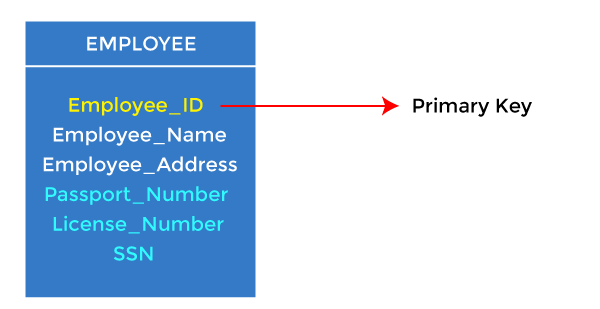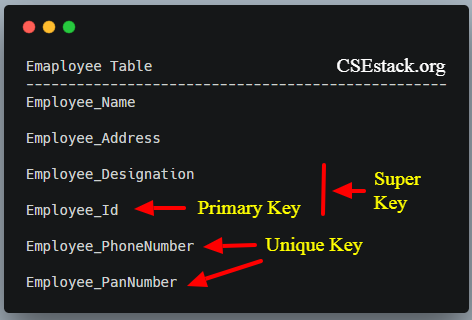Briefly Explain Different Keys in Database With Examples
Explain Database Scheme and Its. Alternate Key in Branch_Info table.

Dbms Keys Primary Foreign Candidate And Super Key Javatpoint
It is a set of one or more attributes that can uniquely identify tuples in a relation.

. You may want to find all accounts in of a specific branch of ABC bank. Imagine you have a STUDENTS table that contains a record for each student at a university. The entity student ID is a key attribute because no other student will have the same ID.
For example a table of customer orders might have a user column with a foreign key. Super Key is a set of properties within a table. It must also have atomicity ie.
It is a set of attributes that uniquely identifies a row. Lets look at each of them separately. It can be divided into smaller sub parts each sub part can form an independent attribute.
There may be more than candidate key and may be a combination of more than one attribute. RABCDE then total no of candidate keys are 5Cfloor5210. Briefly explain with example how key distribution can be achieved.
Primary Key - The primary key is selected from one of the candidate keys and becomes the identifying key of a table. What are the different steps involved in the public key authority key distribution. In a bank account database data is stored sequentially by acc_no.
Primary Key in Branch_Info table. The first to mention the term relational database was Edgar F. The different types of keys in DBMS are.
These types of databases are also sometimes referred to as non-relational databases. The students unique student ID number is a good choice for a primary key in the STUDENTS table. Key attribute has clearly different value for each element in an entity set.
Lets understand secondary indexing with a database index example. There are broadly seven types of keys in DBMS. NoSQL is a broad category that includes any database that doesnt use SQL as its primary data access language.
It can uniquely identify any data row of the table. Primary Key in Student_Information Table. This attribute represents the main characteristic of an entity ie.
The most common and frequently used example of the surrogate key is the auto generated integer values in the increasing sequential order such as 1 2 3 4 5. On the contrary A surrogate key is not a natural key because surrogate key attribute is specifically added to the table as a prime attribute for the purpose of defining the primary key. The above-mentioned anomalies occur because inadvertently we are storing two or more pieces of information in every row of a table.
A table can contain a null value other than the primary key field. Primary Key Example. While we must admit their popularity is growing the relational databases still take up the lions share of the market.
The set of properties like roll no name class age sex is. Of a student is unique in relation. Microsoft SQL Server Oracle Database MySQL PostgreSQL and IBM Db2.
For the table in Img1 if the manager MrXs name has to be updated the update operation must be applied to all the rows that MrX is associated withMissing out even a single row causes inconsistency of data within the database. This is because the primary key value is used to identify individual rows in relation and if the primary key has a null value then we cant identify those rows. Either transactions are completed successfully and committed the effect is recorded permanently in the database or the.
The entity integrity constraint states that primary key value cant be null. Candidate key is a unique case of super key. No of candidate keys in a Relation are nCfloorn2for example if a Relation have 5 attributes ie.
Name FirstName MiddelName LastName. For Example STUD_NO COURSE_NO is a composite candidate key for relation STUDENT_COURSE. The different types of attributes are as follows.
Candidate Key - The candidate keys in a table are defined as the set of keys that is minimal and can uniquely identify any data row in the table. It specially identifies each record in a table. Here you can have a secondary index in DBMS for every search-key.
Several techniques have been proposed for the distribution of public keys. Index record is a record point to a bucket that contains pointers to all the records with their. The attributes of student entity are as follows.
Database systems like any other computer system are subject to failures but the data stored in it must be available as and when requiredWhen a database fails it must possess the facilities for fast recovery. On a technical level a foreign key is a constraint that links a column in one table table_1column_a to a column in a different table table_2column_b and ensures that a value can be added to column_a only if the same value already exists in column_b. Types of Keys in DBMS.
Alternate keys are candidate keys that are not selected as primary key. The candidate key can be simple having only one attribute or composite as well. The students first and last name are not good choices because there is always the chance that more than one student might have the same name.
A primary key is a column of a table or a set of columns that helps to identify every record present in that table uniquely. Alternate key can also work as a primary key. What is a relational database exactly.
A few simple non-relational database examples would be key-value stores document stores or graph databases. Sample of key attribute. A primary key is one of the Candidate Keys.
Suppose you are given the following requirements for a simple database for the football. Alternate key is also called Secondary Key.

7 Different Types Of Database Keys Explained With Example

Database Tables Primary Keys Foriegn Keys And Relationships Database Design Learn Programming Software Development

One To Many Relationship Examples In Database Relationship Database Many
Comments
Post a Comment